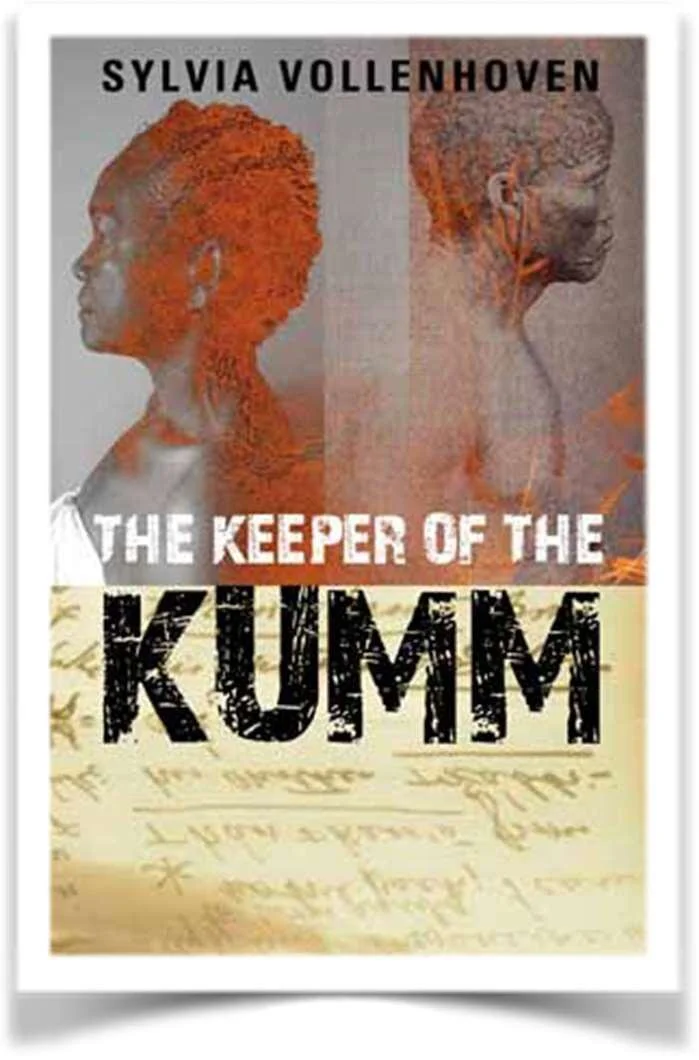//Kabbo
Rainmaker, Storyteller & Visionary (1815 - 1876)
In 1870, //Kabbo, a pipe-smoking revolutionary Bushman visionary, driven by his need to safeguard his fragile culture, travels hundreds of miles to find city people whom he has heard can write down stories and preserve them in books. The result of this vision quest is an archive recorded over a thousand days and nights. More than a century later it is entered into UNESCO’s Memory of the World Register.
The Bleek/Lloyd Archive, housed in the University of Cape Town, contains over one hundred notebooks and more than 12,000 handwritten pages. It is the magnum opus of Victorian philologist Dr Wilhelm Bleek, his sister-in-law Lucy Lloyd and their informants. //Kabbo /Uhi-ddoro Jantje Tooren is the main informant.
Almost two Centuries ago a boy called /Han≠i≠i – his childhood name means Father’s Desire – is born on a winter’s day in 1815 at a small settlement near Kenhardt in the Northern Cape. All around the Bitterputs Well people celebrate. The sixth child of Gwa-/ka and !Kwi-An has the gift that was handed down from his maternal grandmother to his mother.
It is 1815, the year that Napoleon is defeated at Waterloo and Britain becomes the 19th Century super power. That means the Cape is a British Colony for the second time, wrested once more from the Dutch. Hordes of anti-British Settlers, Dutch peasant farmers, move into the hinterland.
Clash of Cultures
/Han≠i≠I the boy named after his father’s yearning and a child with rare talents, grows up at a time when settlers and sometimes other Africans are intent on the complete destruction of his people. He finds himself at the nexus of realities colliding. On the one hand there are his people the /Xam-ka! ei who are guided by their relationship with the spirit world and then there are the interlopers, hungry for land. Dutch Boer commandos, sometimes aided by Korana and Khoekhoe people, form supposed ‘hunting parties’. Their real aim, mostly kept secret from the authorities, is the mass slaughter of the /Xam-ka !ei.
When the gifted boy is only nine years old a great famine kills his father and two older brothers. After the initiation rites of his first hunt his adult name becomes //Kabbo, The Visionary or Dreamer. He is a young man in his early thirties when the British colonial governor extends the boundaries of the Cape Colony, taking away almost all his people’s land. //Kabbo has a vision that he has to do battle, he has to retaliate.
A Resistance Movement
The Dreamer, the settlers call him Jantje Tooren and his friends know him as /Uhi-ddoro The Tinder Box, goes on a Crusade. The white people call the Crusaders ‘The Tooren Gang’. They say they are nothing but cattle rustlers. The activists fight back against the genocide. They poison water supplies, steal the settlers’ stock and attack frontier farmers. The Tooren Gang become the heroes of the !Xam-ka !ei. The British colonial authorities in the distant Cape have no way of combating their guerrilla tactics. The dissident Dutch farmers in turn learn this indigenous style of resistance from //Kabbo’s people and employ it to go to War with the British.
Nobody knows the terrain better than //Kabbo and his activists because this is their land. They know the hills and valleys. They know the animals and plants. They know the seasons and the dangers. Most importantly they even know the spirit shape of things when the land sleeps. Knowledge that has been handed down, they say, from The First People. Their enemies are at a great disadvantage. But The Dreamer & his Crusaders cannot hold out against armed commandos that are becoming larger. The colonial authorities at the Cape have offered a reward for the capture of the leader of The Tooren Gang.
//Kabbo has a vision even more compelling than the one that led him to mount a revolutionary Crusade. The Visionary who loves his pipe and who is also known as /Uhi-ddoro The Tinder Box, sees that the salvation of his people lies in their stories. He dreams of a settler woman who will be able to hear the /Xam language and who will fix their stories on paper. He dreams that the stories will save his people from complete annihilation.
//Kabbo the Master Storyteller, who knows his terrain better than any interloper, allows himself and some of his fellow crusaders to be captured. The colonial authorities dump them in a prison in Cape Town where convicts have to build the new breakwater for the Table Bay harbour.
Forces Combine
As it always is with an epic story, the forces that combine in response to //Kabbo’s powerful vision spans continents. In Germany Dr Wilhelm Bleek, a passionate academic given to bouts of illness, is drawn to Africa to study dying languages. In Britain the family of Lucy Lloyd, a governess, follows in the wake of the 1820 Settlers and sets sail for Durban. Escaping from the clutches of an abusive father Lucy and her sister Jemima meet up with linguist Dr Bleek. It is not long before Jemima and Wilhelm are married in Cape Town. It is then that the ailing but determined Dr Bleek begins the linguistic work that defines the last stages of his life with the help of his sister-in-law Lucy.
At around this time a law is passed that moves the boundary of the Cape Province from the Sak to the Orange River, taking away even more of the traditional hunting grounds of the /Xam people. When they attempt to feed their families, more and more people like //Kabbo are arrested for stock theft and taken to the Breakwater Prison.
In the spring of 1870 Dr Wilhelm Bleek and Lucy Lloyd are in the Prison looking for people who can help them compile a dictionary of the dying /Xam language. At first they take Akunta, one of the younger members of the Tooren Gang, to live with them in their house called The Hill in Mowbray. But after a few months of patiently teaching his language and telling his stories to the Bleek-Lloyd team Akunta says they need the skills of //Kabbo, a Master Storyteller. And so it is that the first part of //Kabbo’s Vision Quest becomes reality.
When //Kabbo The Visionary sees Lucy Lloyd and her brother-in-law hunting for informants at the Breakwater Prison, he knows that this is the woman he saw in his dream. The prison authorities give permission for him to move to the Bleek household called The Hill in Mowbray.
When I first read //Kabbo’s poetic stories in the Bleek-Lloyd archive, I struggle to understand the awkwardness of the archaic expressions. I feel frustrated by a text that has made many twists and turns from his original thought in a lost language, via Lucy Lloyd’s Victorian sensibilities to the straight jacket of English. But the gift of the archive is a work of art that we can embrace and make our own. I begin to play with the heritage he has left us and find an unwritten, unseen richness behind the words.
Our Heritage At the UN
In 1997 the Lloyd-Bleek collection of San folklore is entered into UNESCO’s Memory of the World Register. It is a heritage that is not known to most of the descendants of //Kabbo and the /Xam-ka !ei people whose language has been wiped out.
Our communities devastated by crime, addiction and poverty could benefit greatly from the healing power of //Kabbo’s stories. Instead of raising our children on foreign folklore only we could instill a sense of pride and belonging with stories like these:
The girl arose, the girl of the Early Race
!Xwe-|na-ssho-!ke
She put her hands into the wood ash
Threw it up into the sky. She said to the wood ash
You must become the Milky Way
You must white lie along in the sky
The Milky Way is the Milky Way
while it used to be wood ash
My mother is the one who told me
Inspired by images of a young Bushman girl flinging stars about the heavens, we will find ourselves in the narratives of our lives, in the contested history of our country. We, the ‘baster’ descendants of the likes of /Han≠i≠i //Kabbo /Uhi-ddoro Jantje Tooren, have been all but removed from the official history.
They also called //Kabbo Mantis Man because he could command the rain. His other name, Tinder Box or /Uhi-ddoro alluded to his ability to make magical things happen, or bring light. //Kabbo the storyteller could ignite the spark of imagination. He could understand //Kaggen the Mantis, the essence of the paradox of the Universe. Small and fragile yet looming large in any shape or form he chooses. Sometimes benign, sometimes cruel and mostly chaotic. Outsiders who struggle to understand call him a ‘trickster’. Others bestow on him the persona of Satan. The ignorant call him simply “hotnotsgod”. The Mantis wears it all with ease as the stories in the Bleek-Lloyd archive show.
Engaging With Ancestors
Rupert Sheldrake, British scientist and author, renowned for his propositions around ‘morphic fields’, says mental activity is non-local, not confined to the insides of our brains or bodies for that matter. Thought extends far beyond the brain much in the same way that cell phone communication is not bound to the handset. This kind of scientific concession to the fluidity of human existence is a backdrop to engaging with //Kabbo and the stories of our ancestors. Globally there is an awakening to a new way of thinking, a new way of seeing ourselves in the landscape of the past. In this awareness neat time lines give way to a non-linear, interrelated reality that reflects Einstein’s assertion that we only invented time because we could not cope with everything happening at once.
//Kabbo contributed traditional stories to the Bleek-Lloyd collection as well as biography, history and cultural information. These are invaluable resources for historians, anthropologists and our people who wish to benefit from a /Xam perspective on contemporary events on the Cape frontier in the nineteenth century or who want to understand /Xam culture. His narratives are also notable for their length and complex plot development. One story, writes Andrew Bank about Jupiter and his child, “runs over five notebooks, 300 pages and five months…” Lucy Lloyd observed of //Kabbo that he was “an excellent narrator, and patiently watched until a sentence had been written down, before proceeding with what he was telling. He much enjoyed the thought that the Bushman narratives would become known by way of books.”
References, Acknowledgements & Links
The Keeper of the Kumm by Sylvia Vollenhoven (Tafelberg). Full details of The Keeper of the Kumm project that comprises a film, a book (Tafelberg 2016) and a musical theatre adaptation can be found at www.visioninafrica.com. Kumm is the word for story or anything told and retold in the now extinct /Xam language.
Claim to the Country by Pippa Skotnes (Jacana & Ohio University Press)
My Heart Stands In the Hill by Janette Deacon & Craig Foster (Struik)
The Broken String: The Last Words of an Extinct People by Neil Bennum
Bushmen In A Victorian World – The Remarkable story of the Bleek-Lloyd Collection of Bushman folklore by Andrew Bank (Double Story)
The Digital Bleek & Lloyd, University of Cape Town Centre for Curating the Archive http://lloydbleekcollection.cs.uct.ac.za/
The Courage of ||kabbo: Celebrating the 100th anniversary of the publication of Specimens of Bushman Folklore edited by Janette Deacon and Pippa Skotnes (UCT Press)


